UK Steel Crisis Continues to Stymie Confidence; GBP/EUR Forecast to Plummet Further
The Pound Sterling to Euro (GBP/EUR) exchange rate declined by around -1.2% on Friday afternoon.
In response to less-than-ideal domestic data, the British Pound weakened versus all sixteen of its most traded currency peers. March’s UK Manufacturing PMI was projected to advance from 50.8 to 51.4, but the result actually only reached 51.0. This has flagged up concerns regarding imbalanced economic growth as the UK continues to rely on consumption.
‘The UK manufacturing sector remained in the doldrums during the opening quarter of the year. Although March saw modest improvements in the trends for production and new orders, industry is still hovering close to the stagnation mark and will struggle to make a meaningful contribution to the next set of GDP growth figures,’ said Markit economist Rob Dobson.
With the UK steel crisis causing many to fear the end of British steel production and significant job losses, demand for the Pound was already reduced. Manufacturing output is likely to decline further over the coming months given that the current issues surrounding steel manufacturing are unlikely to be resolved speedily.
The Pound Sterling to Euro (GBP/EUR) exchange rate is currently trending in the region of 1.2477.
Euro to Pound Sterling (EUR/GBP) Exchange Rate Forecast to Rally after Eurozone Manufacturing Output Bettered Estimates
With the exception of France, Euro-area manufacturing output provided a contrasting picture to that of the UK’s. Manufacturing output in Italy, Germany and the Eurozone as a whole all bettered the respective market consensuses.
In response to the Eurozone Manufacturing PMI, Chris Williamson, Chief Economist at Markit said; ‘Pockets of brighter light persisted outside of the core. With the exception of Greece, which remained in decline, most other countries surveyed — including Spain, Italy, the Netherlands and Austria — saw robust rates of growth. However, it was Ireland, where the economy continues to boom, which topped the growth rankings on the back of rising domestic and export sales.’
The Euro’s appreciation today is likely to be of concern to European Central Bank (ECB) policymakers. Today marks the beginning of the latest set of asset purchases, a monetary stimulus tool designed to devalue the domestic currency. In fact, despite the current quarter seeing the ECB announce massive stimulus measures, the Euro has seen the strongest quarterly performance in five years.
The Pound Sterling to Euro (GBP/EUR) exchange rate dropped to a low of 1.2460 during Friday’s European session.
GBP/EUR Exchange Rate Forecast: Sterling to Hold Losses on Political Uncertainty
Given that the forthcoming EU referendum and the current UK steel crisis is contributing heavily to political uncertainty, there is a high chance that the British Pound will hold losses versus the single currency over the weekend.
Monday is likely to see GBP/EUR exchange rate volatility in response to domestic data. For those invested in the Pound, March’s Construction PMI will be of significance. This is especially true considering many analysts are concerned over imbalanced UK growth.
For those trading with the common currency, February’s Eurozone Unemployment Rate is very likely to cause Euro volatility.
The Pound Sterling to Euro (GBP/EUR) exchange rate reached a high of 1.2627 during Friday’s European session.



